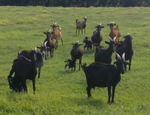
KAO Rowland Raymond
- Roslin Institute, University of Edinburgh, Edinburgh, United Kingdom
- Animal epidemiology, Ecology, Farming systems, Infectious diseases, Mathematical modelling, Population dynamics, Veterinary epidemiology
- recommender
Recommendation: 1
Review: 1
Recommendation: 1

A modelling framework for the prediction of the herd-level probability of infection from longitudinal data
Modelling freedom from disease - how do we compare between countries?
Recommended by Rowland Raymond Kao based on reviews by Arata Hidano and 1 anonymous reviewerIn this paper, Madouasse et al. (2021) present a generalisable Bayesian method for calculating the probability that a herd is free from disease, based on its prior disease status, and using data (herd status over time over a sufficient number of herds to inform the model) and reasonable prior estimates of the sensitivity and specificity of tests being used to determine animal infection status. Where available, the modelling approach can also include relevant additional risk factors.
By bringing all these factors together, it allows for most countries to use the same analytical approach on their data, with differences across datasets expressed in terms of the uncertainty around the central estimates.
Having a single methodology that generates both a central estimate of disease freedom, and uncertainty thus provides the opportunity (given typically available data) to compare the probability of freedom across different systems. This is relevant in terms of the context of trade (since international trade of livestock in many cases depends on disease freedom). It is also important when evaluating, for example, transnational burdens of disease - and with different regulations in place in different countries, this is invaluable and can be used, for example, to assess risks of zoonotic infection including for zoonotic infection emergence. In the BVD example provided, the point is made that, since regular testing would probably pick up infection rapidly, the addition of risk factors is most valuable where testing is infrequent. This emphasizes the advantages of direct incorporation of risk factors into a single modelling framework.
From a technical point of view, the analysis compares two different packages for the Markov Chain Monte Carlo (MCMC) implementation necesary to run the model. They show that, while there are some slight systematic differences, the estimates provided by the two methods are similar to each other; as one method is approximate but substantially more stable and generally much more computationally efficient, this is an important outcome. Both implementations are freely available and with relevant additional software made similarly available by the authors. This is extremely welcome and should encourage its general adoption across different countries.
No single model can of course account for everything. In particular, the reliance on past data means that there is an implicit assumption common to all purely statistical methods that the underlying risks have not changed. Thus projections to altered circumstances (changing underlying risk factors or systematic changes in testing or test performance) cannot so easily be incorporated, since these factors are complicated by the dynamics of infection that lie outside the modelling approach. Of course the well known quote from George Box that "all models are wrong" applies here - the generality of approach, statistical robustness and open source philosophy adopted make this model very useful indeed.
Madouasse A, Mercat M, van Roon A, Graham D, Guelbenzu M, Santman Berends I, van Schaik G, Nielen M, Frössling J, Ågren E, Humphry RW, Eze J, Gunn GJ, Henry MK, Gethmann J, More SJ, Toft N, Fourichon C (2021) A modelling framework for the prediction of the herd-level probability of infection from longitudinal data. bioRxiv, 2020.07.10.197426, ver. 6 peer-reviewed and recommended by PCI Animal Science. https://doi.org/10.1101/2020.07.10.197426
Review: 1

OneARK: Strengthening the links between animal production science and animal ecology
When scientific communities intertwine
Recommended by Pauline Ezanno based on reviews by Rowland Raymond Kao, Arata Hidano and 1 anonymous reviewerScientific research can be seen by some as a competitive territory: competition of opinions, concepts, publications, competition for funding. Fortunately, it is above all a territory of sharing and cross-fertilization of ideas. It is gradually becoming a territory of productive interdisciplinary collaborations, despite persistent resistance to making borders more permeable [1]. At the crossroads of worlds, many challenges must be met for communities to understand each other, to be able to communicate with one another, and to benefit mutually from scientific interactions [2].
Delphine Destoumieux-Garzon and co-authors [3] propose to stimulate a single Animal Research Kinship (OneARK) to promote the crossing of the scientific communities in animal production and animal ecology. These two communities share many concepts and methods, which, while they are based on marked specificities (natural versus artificial systems), also and above all have common points that need to be explored more closely. Seven concepts of shared interest to improve the resilience and sustainability of animal population systems were explored by the authors: selection, system viability, system management, animal adaptability, inter-individual diversity in systems, agroecology, and animal monitoring.
This foundation stone paves the way for a finer integration between these two communities, which are close and yet distant, and which are slowly getting to know, understand, and recognize each other.
References
[1] Ledford, H. (2015). How to solve the world’s biggest problems. Nature, 525, 308–311. doi: 10.1038/525308a
[2] Knapp, B., Bardenet, R., Bernabeu, M. O., Bordas, R., Bruna, M., Calderhead, B., … Deane, C. M. (2015). Ten simple rules for a successful cross-disciplinary collaboration. PLoS Computational Biology, 11(4), e1004214. doi: 10.1371/journal.pcbi.1004214
[3] Destoumieux-Garzón, D., Bonnet, P., Teplitsky, C., Criscuolo, F., Henry, P.-Y., Mazurais, D., … Friggens, N. (2020). OneARK: Strengthening the links between animal production science and animal ecology. Ver 6 Peer-Reviewed and Recommended by PCI Animal Science. doi: 10.5281/zenodo.3632731